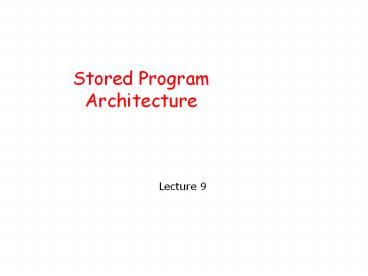Stored Program Architecture - PowerPoint PPT Presentation
1 / 18
Title: Stored Program Architecture
1
Stored Program Architecture
- Lecture 9
2
The von-Neumann Architecture
- Stored Program Concept - Storing instructions in
memory along with data - Memory
- Processor - CPU
- Input/Output devices
3
I/O
- input/output devices enable the user to interact
with the computer - input devices keyboards, mice, scanners,
- output devices display screens, speakers,
printers,
4
Main Memory
- Main memory is a large number of memory
locations. Each location is accessible via an
address. It holds - Data
- Active programs - instructions for the CPU.
Storing the instructions for the cpu in memory
called the stored program concept (Von Neumann) .
Program is stored in the machine language
(binary) that corresponds to the circuitry of
that processor.
5
Memory
- Programmer writes a program in a high level
language that is easy to understand, like Java,
C or JavaScript. - Program is translated into machine language by a
compiler or interpreter. - The binary code is stored in the main memory
along with the data.
6
CPU Central Processing Unit
- ALU - arithmetic/logic unit circuitry for
arithmetic and logic operations (e.g. addition,
comparison, OR) - CU - control unit
- fetches instructions from memory
- decodes the instruction
- executes the instruction
- registers
- memory locations built into the CPU (to provide
fast access) - hold data for immediate use by ALU
7
Bus
- Just like it sounds. What does a bus do?
- Buses are circuits over which data travels
- Buses connect parts of the the CPU and main
memory - Takes time to get data from main memory, so its
slower than registers.
8
CPU
- CPU acts as the brain of the computer
- it fetches data and instructions from memory
- it executes the instructions
- it stores results back to memory
- (Be patient for a few slides)
9
(No Transcript)
10
Control Unit
- The control unit
- fetches instructions from memory
- decodes the instruction
- executes the instruction
- The control unit has two important registers
- PC- program counter - contains the address in
main memory of the next instruction - IR- instruction register - holds the instruction
that is currently executing
11
Machine cycle
- The control unit
- fetches from main memory the instruction whose
address is in the program counter. The
instruction is stored in the instruction register
and the program counter is incremented to the
next instruction address. - decodes the instruction to understand what needs
to be done. - executes the instruction by performing the
operation on the data.
12
- The above three steps are repeated until the end
of the stored program. - A computer can execute millions of instructions
per second.
13
Example
- Spose the control unit is executing an
instruction to add two numbers - obtain first value from memory and store in a
register - obtain second value from memory and store in a
register - use the addition circuitry to add the two numbers
in the registers and place the result in a
register - store the result in main memory
14
HW
- Please read chap 14 and bring book to class for
lab 9 - The next few slides are preparation for the lab.
They are a continuation of the Addition Example
15
Assembly language
- 0 LOAD R0 5 // R0 M5
- 1 LOAD R1 6 // R1 M6
- 2 ADD R2 R0 R1 // R2 R0 R1
- 3 STORE 7 R2 // M7 R2
- 4 HALT // HALT
- 5 9 // 9 data value
- 6 1 // 1 data value
- 7 0 // will hold result
16
Machine Language (no spaces)
- 0 100000010 00 00101 // R0 M5
- 1 100000010 01 00110 // R1 M6
- 2 1010000100 10 00 01 // R2 R0 R1
- 3 100000100 10 00111 // M7 R2
- 4 1111111111111111 // HALT
- 5 0000000000001001 // 9 data value
- 6 0000000000000001 // 1 data value
- 7 0000000000000000 // will hold result
17
Simulator Machine Language
- 1st two instructions select ALU operation and
registers to operate on - next 3 instructions control flow of data. Store
should be location 5. - last instruction marks the end of instruction
sequence
18
Program Execution
- example machine language program for adding two
numbers in memory - program execution
- program counter is initialized PC 0
- instruction at memory location 0 is fetched, PC
is incremented to 1 - instruction is decoded and CPU cycle is executed
load contents of memory location 5 into RO - next instruction is fetched at location 1, PC is
incremented to 2 - instruction is decoded and CPU cycle is executed
load contents of memory location 6 into R1 - next instruction at memory location 2 is fetched,
PC is incremented to 3 - instruction is decoded and CPU cycle is executed
add contents of R0 and R1, store result in R2 - next instruction at location 3 is fetched, PC is
incremented to 4 - instruction is decoded and CPU cycle is executed
copy contents of R2 into memory location 7































